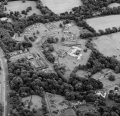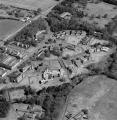Gogarburn Hospital
| Gogarburn Hospital | |
|---|---|
 | |
| Established | 1913 |
| Opened | 1924 |
| Closed | 1999 |
| Current Status | Demolished |
| Building Style | Cottage Plan |
| Location | Gogarburn |
| Alternate Names | |
History[edit]
In 1913 the Mental Deficiency and Lunacy (Scotland) Act was passed by Parliament. It gave statutory recognition to the distinction between mental illness and mental handicap, and required District Boards of Control to provide institutions for the mentally handicapped separate from the asylums, which were now to concentrate on the treatment of the mentally ill.
It was some 15 years later that the Edinburgh District Board of Control complied with the Act and bought the mansion house and estate of Gogarburn. The house had previously belonged to the Edinburgh Corporation, and had been used as a home for convalescent and delicate children under school age.
By December 1924 the hospital was open with 24 women patients in residence and, in 1925, the stable block was adapted to accommodate 15 men. The District Board now commissioned Stewart Kaye, the architect of Bangour Village Asylum, to design a colony for Gogarburn to accommodate, ultimately, 1,000 mentally handicapped people. The colony was designed as a small village, each house or block to take 50 patients under the supervision of a housekeeper. In 1929 the foundation stone of the new administrative block was laid by the Duke of York. In April 1930 this building and the two villas close to it were formally opened by the Secretary of State for Scotland.
In 1925 the hospital bought its first farm, Kellerstain, to provide work and food for the patients. In 1950 it added the farm of Gogarbank and the policies of Hanley Lodge. Following the passing of the Local Government (Scotland) Act in 1929 the District Board of Control was disbanded and the administration of Gogarburn was transferred to Edinburgh Corporation and was managed by the Public Health Committee and the City's Medical Officer of Health.
Building went on steadily. In 1931 the school was opened and Scout and Guide troops were formed. In 1934 two more villas were opened. In 1936 two children's blocks were added, followed in 1938 by two "temporary" blocks for male patients. By the end of 1938 there were places for 540 patients.
In 1937, following a circular from the General Board of Control, a conference was held in Edinburgh and it was decided that, although Gogarburn should remain an Edinburgh Corporation hospital, it would be used by all South Eastern authorities "provided the charges made to them by the Corporation were not excessive". Before this arrangement became effective World War II broke out.
In 1940 the Government decided to include Gogarburn in the emergency services scheme. Two new villas, not yet in use, were taken over, and further accommodation for emergency purposes was acquired by transferring 130 men to Larbert Institution and putting more patients in each ward. The hospital dealt with a steady flow of surgical cases from the Army and Airforce during 1940 while the transformation to an emergency hospital was being carried out under the guidance of Professor Learmonth. In 1942 over 1,700 service and civilian patients were treated, and Gogarburn acquired a reputation for its highly specialised peripheral nerve unit. In 1943 the 130 men who had been sent to Larbert Institution were returned to Gogarburn and, to ease the ensuing crowding, 30 youths were sent to Lennox Castle Hospital. In 1944 admissions to the hospital were restricted and the complete staff of a surgical unit was transferred to a hospital in the South of England in preparation for the Normandy Landings. By 1945 there was a long waiting list of patients for Gogarburn as it returned to its original function. There was also an acute shortage of nursing staff.
Gogarburn was transferred in 1948 to the South Eastern Regional Hospital Board under its own Board of Management. The Board continued to try to provide a regional service against the perennial problem of staff shortage. Two new wards and an occupational therapy hut were built.
In 1960 the Mental Health (Scotland) Act was passed allowing for patients to be admitted on an informal basis instead of being certified and formally admitted. Gogarburn, therefore, developed from a custodial hospital where patients were cared for and given work to do to bring in money, into a treatment and training centre. The emphasis changed from work to occupational therapy. This led to the provision of hostels and sheltered homes where patients who had benefitted from training could go and live, thus leading more normal lives. In 1969 the Gogarburn Board of Management was disbanded and the hospital's management was transferred to the Board of Management of Royal Edinburgh and Associated Hospitals. In 1971 two units for adolescents and the Industrial Therapy Unit were opened, followed in 1972 by the Children's Unit.
In 1974 Gogarburn became part of the South Lothian District of Lothian Health Board, and in 1986 part of the Mental Health Unit. The hospital closed in May 1999.

